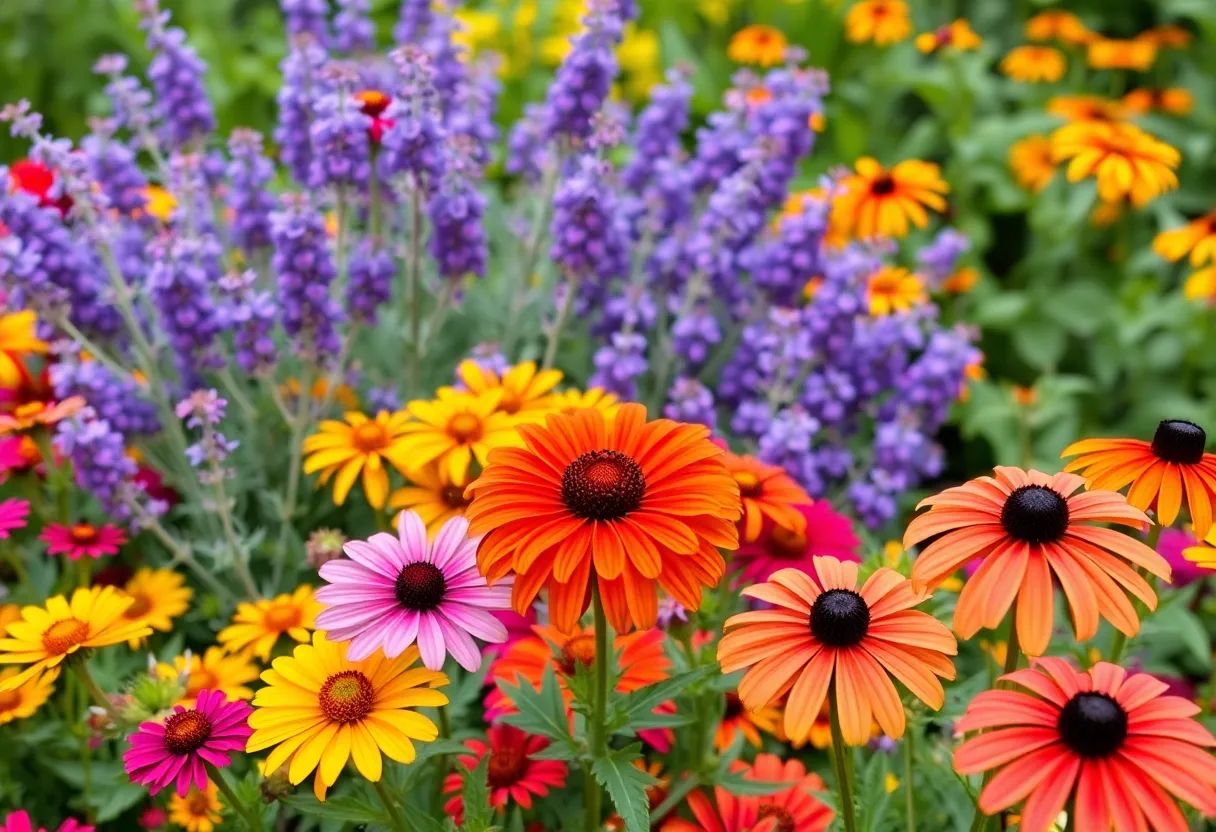10 Best Low-Maintenance Plants for a Beautiful Houston Garden
Designing a thriving garden in Houston requires selecting plants that can withstand the area’s intense heat, humidity, and variable rainfall. The key lies in choosing species that require minimal care while providing color, texture, and ecological benefits. The following list features ten low-maintenance plants ideal for Houston’s climate, emphasizing resilience, adaptability, and visual appeal.
1. Texas Sage (Leucophyllum frutescens)
Texas Sage stands out for its drought tolerance and ability to survive in poor, well-drained soils. Characterized by its silvery foliage and vibrant purple blooms, it predominantly flowers after rainfall, making it a natural indicator of moisture levels. Its resilience to heat and drought makes it ideal for Houston landscapes. This shrub requires full sun for optimal flowering and minimal watering once established. Its low maintenance nature reduces the need for pruning, though occasional trimming encourages bushier growth.
2. Lantana (Lantana urticoides)
Lantana offers a spectrum of flower colors—orange, yellow, red, and pink—that can brighten any garden. It attracts butterflies and hummingbirds, supporting local pollinators. Known for its drought resistance and pest immunity, it thrives in full sun with well-drained soil. Its sprawling growth habit allows it to serve as ground cover or spill over garden beds. Regular pruning after flowering prevents overgrowth while promoting continuous blooms.
3. Black-Eyed Susan (Rudbeckia hirta)
Black-Eyed Susan is a hardy perennial that blooms from spring through fall, offering bright yellow petals with dark centers. Its adaptability to full sun and drought conditions makes it a staple for Houston gardens. It tolerates a range of soil types, provided drainage is adequate. Its natural resistance to pests and diseases ensures low upkeep, with minimal pruning necessary beyond deadheading spent flowers for prolonged blooming.
4. Autumn Sage (Salvia greggii)
Autumn Sage is prized for its long-lasting flowers and ability to rebloom throughout late spring to hard frost. Its red blossoms are especially attractive to hummingbirds. Preferring well-drained soil and full sun, this perennial demands minimal watering once established. It benefits from light pruning after flowering to maintain shape and encourage vigorous new growth.
5. Esperanza (Tecoma stans)
Esperanza, or Yellow Bells, is a heat-tolerant shrub with bright, trumpet-shaped yellow flowers. Its rapid growth and prolific blooming make it a favorite for vibrant landscapes. It prospers in full sun and tolerates drought once established. Prune in early spring to promote dense growth and abundant flowering. Its ability to handle humidity and heat reduces the need for supplemental watering or pest control.
6. Firebush (Hamelia patens)
Firebush is a striking shrub with fiery red-orange flowers from spring to fall. Its attractiveness to hummingbirds and butterflies supports local ecosystems. It’s highly drought- and heat-tolerant, making it one of the most resilient choices for Houston gardens. With regular pruning, it can be maintained as a small tree or dense shrub, requiring minimal fertilization or pest management.
7. Plumbago (Plumbago auriculata)
Plumbago features airy clusters of sky-blue flowers, providing a cooling contrast to warm surroundings. Sometimes grown as ground cover, it spreads rapidly and can fill large areas with minimal intervention. It prefers full sun and well-drained soil. Regular trimming prevents overgrowth, and its drought tolerance reduces watering needs significantly.
8. Mexican Petunia (Ruellia simplex)
Mexican Petunia is adaptable to a range of light conditions, thriving in full sun or partial shade. Its purple, pink, or white blooms appear throughout the growing season, adding color without demanding excessive care. Known for pest and disease resistance, it performs well in various soil types. Its fast-growing nature benefits from occasional trimming to slow its spread and maintain desired shape.
9. Yaupon Holly (Ilex vomitoria)
Yaupon Holly remains evergreen year-round, offering dense foliage and winter red berries that attract birds. It tolerates poor soil and can grow in full sun or partial shade. Its versatility makes it suitable for hedging or standalone accents. Minimal pruning is necessary, typically only to shape or remove dead branches, and it requires little supplemental watering once established.
10. Gulf Coast Muhly (Muhlenbergia capillaris)
Gulf Coast Muhly is valued for its wispy pink flower plumes that appear in fall, creating a soft, flowing texture. Its drought resistance and erosion control capabilities make it practical for a variety of landscape applications. Preferring sunny locations with well-drained soil, it requires minimal maintenance. Occasional trimming of dead or damaged foliage encourages healthy growth and enhances visual appeal.
Integrating Low-Maintenance Plants in Houston Landscaping
Choosing these plants aligns with the goal of less labor-intensive, sustainable gardening. They handle Houston’s heat and humidity while offering various textures, colors, and ecological benefits. Proper placement, including soil preparation and receiving adequate sunlight, optimizes their performance. Regular but minimal maintenance, such as pruning and occasional watering during droughts, sustains their health and appearance.
Conclusion
Implementing these low-maintenance plants in your Houston landscape simplifies gardening while elevating visual interest. Selecting plants that are naturally suited to local conditions minimizes resource use and reduces ongoing effort. Proper planning and understanding each plant’s specific needs enhances the sustainability and enjoyment of your garden over time.
Frequently Asked Questions (FAQ)
What are the benefits of low-maintenance plants in Houston?
Low-maintenance plants reduce water, fertilizer, and pruning requirements, conserving resources. They are well-suited to Houston’s climate, requiring less effort to sustain while providing continuous visual appeal and ecological benefits.
Which low-maintenance plants are best for drought-prone areas?
Plants such as Texas Sage, Lantana, Firebush, and Gulf Coast Muhly are particularly drought-tolerant, requiring minimal watering after establishment and thriving in dry soils.
How often should I prune these low-maintenance plants?
Pruning generally occurs annually or biannually, focusing on removing dead or damaged growth. For flowering shrubs like Autumn Sage and Esperanza, light deadheading encourages prolonged blooming. Formal pruning depends on the specific plant and desired shape.
Can these plants handle Houston’s humidity and heavy rain?
Yes, most of these plants are naturally adapted to Houston’s humidity and heavy seasonal rains. Their tolerance reduces disease risk and supports healthy growth without extensive intervention.
Key Features Comparison
| Plant | Sunlight | Water Needs | Bloom Period | Ecological Benefits |
|---|---|---|---|---|
| Texas Sage | Full Sun | Low | Post-Rainfall | Pollinator Attraction |
| Lantana | Full Sun | Low | Spring to Fall | Butterflies & Hummingbirds |
| Black-Eyed Susan | Full Sun | Moderate | Spring to Fall | Bee & Butterfly Support |
| Autumn Sage | Full to Partial Sun | Low | Late Spring to Frost | Hummingbird Attraction |
| Esperanza | Full Sun | Low | Summer | Pollinator Support |
| Firebush | Full Sun | Low | Spring to Fall | Hummingbirds & Butterflies |
| Plumbago | Full Sun | Moderate | Spring through Fall | Pollinator Support |
| Mexican Petunia | Full to Partial Shade | Moderate | Spring to Fall | Attracts Pollinators |
| Yaupon Holly | Full to Partial Shade | Low | All Year (Berries in Winter) | Bird Food & Shelter |
| Gulf Coast Muhly | Full Sun | Low | Fall | Erosion Control & Aesthetic Value |
Author: STAFF HERE HOUSTON TX WRITER
The HOUSTON STAFF WRITER represents the experienced team at HEREHouston.com, your go-to source for actionable local news and information in Houston, Harris County, and beyond. Specializing in "news you can use," we cover essential topics like product reviews for personal and business needs, local business directories, politics, real estate trends, neighborhood insights, and state news affecting the area—with deep expertise drawn from years of dedicated reporting and strong community input, including local press releases and business updates. We deliver top reporting on high-value events such as Houston Livestock Show and Rodeo, Art Car Parade, and Chevron Houston Marathon. Our coverage extends to key organizations like the Greater Houston Partnership and Houston Area Urban League, plus leading businesses in energy and healthcare that power the local economy such as ExxonMobil, Schlumberger, and Houston Methodist. As part of the broader HERE network, including HEREAustinTX.com, HERECollegeStation.com, HEREDallas.com, and HERESanAntonio.com, we provide comprehensive, credible insights into Texas's dynamic landscape.





